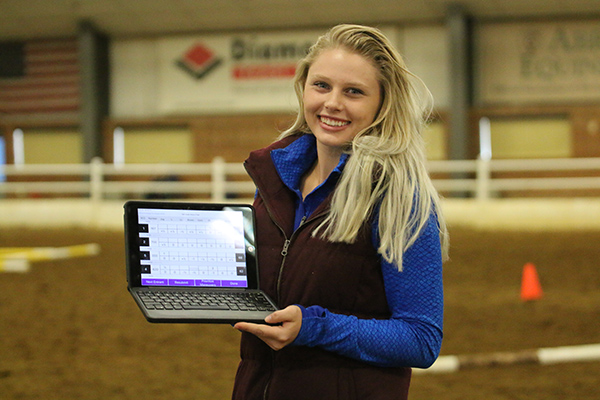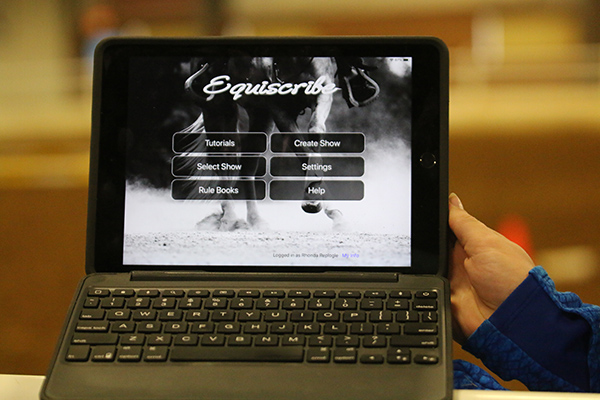Judge/Electrical Engineer Develops Innovative Scribe App For Horse Shows

Photos courtesy of Beth Foster-Hattan
By: Brittany Bevis
We all know that volunteers are the backbone of the horse show, but the position of scribe is one of the most stressful and under-appreciated. A scribe acts as a personal assistant for a judge- noting marks of plus, check, or minus, dutifully recording comments, and praying that their math skills hold up after hours in the show pen.
This is done so that a judge can watch a Horsemanship pattern or Over Fence course without missing a moment, because it’s during those second-long glances at the scoresheet that something big might happen that could ultimately affect the outcome of a class. Just read Confessions of a First Year Scribe and you will see how daunting this volunteer-based position can be.
Judge and electrical engineer by trade, Matthew Saterbak, wanted to come up with a way of making the job of a scribe a bit easier. His invention also ensures that, in the case a scribe cannot be found, a judge can be confident in his or her ability to record scores with ease. Matthew’s tool is a free app called Equiscribe, LLC, which is available in the iPadOS App Store.
Show Manager Cindy Westphal incorporated the use of the app at the Iowa Paint Horse Club’s State Show and Futurity and Minnesota Paint Horse Association’s show.
 “I can’t tell you how using Equiscribe’s pattern scoring app makes the job of show management so much easier!” Cindy says. “Not only does this app take away the stress from the scribes, which makes it easier to get volunteers, it speeds up the pattern classes, because the app does all the math, and the scribes aren’t added and re-adding. The results are radioed to our announcer faster, plus the score sheets are much easier to read.”
“I can’t tell you how using Equiscribe’s pattern scoring app makes the job of show management so much easier!” Cindy says. “Not only does this app take away the stress from the scribes, which makes it easier to get volunteers, it speeds up the pattern classes, because the app does all the math, and the scribes aren’t added and re-adding. The results are radioed to our announcer faster, plus the score sheets are much easier to read.”
“One of our judges, Nancy Wilde, was ‘wild’ about it! The judges and scribes at the Iowa show also loved it. Also, we didn’t have to beg for scribes! In fact, the one scribe who I thought would hate it, took it away from our volunteer and pretty much taught himself how to use it.”
How did Matthew come up with this idea? As a MN 4-H, WSCA, and POA judge for the past ten years, it came out of necessity. “I wanted to try to adopt the check, check plus, check minus system a couple of years ago to keep myself current with the majority of breed associations,” Matthew says. “But, I found it was really difficult to practice outside of an actual show environment, and it can be impossible to find a scribe at the majority of shows that I judge at. I didn’t really feel like it was fair to the exhibitors for me to try to learn on the fly, so I went about creating a tablet system that would do all of the arithmetic for me and make it easier for a rookie scribe to pick it up and feel comfortable.”
Currently, the app can be used for Horsemanship, Showmanship, Equitation, Trail, Obstacle Driving, Reinsmanship, Reining, Western Riding, Ranch Riding, and Longe Line classes. Currently under development are updates to include Cutting, Reined Cow Horse, Dressage, Western Dressage, and Over Fence classes.
 How does it work? “The app itself is fairly straightforward. The judge or show manager sets up the show in advance, choosing the pattern classes they wish to have judged and which patterns to apply to them. During each run of a pattern, the tablet shows which maneuver is currently being judged and has options to choose the available penalties prescribed by the breed association. When the scribe chooses a maneuver score for that maneuver, the program moves on to the next maneuver to be judged. Throughout a class, the total scores for all the pattern runs are accumulated and the scores can be sorted automatically, even doing tie breaks automatically.”
How does it work? “The app itself is fairly straightforward. The judge or show manager sets up the show in advance, choosing the pattern classes they wish to have judged and which patterns to apply to them. During each run of a pattern, the tablet shows which maneuver is currently being judged and has options to choose the available penalties prescribed by the breed association. When the scribe chooses a maneuver score for that maneuver, the program moves on to the next maneuver to be judged. Throughout a class, the total scores for all the pattern runs are accumulated and the scores can be sorted automatically, even doing tie breaks automatically.”
All that’s required to use the app is an iPad that runs iPadOS 13. Internet connectivity is only needed to download the app and to load the pattern library. Matthew explains that the actual scoring doesn’t require internet connectivity; however, in order to print or upload final scoresheets, either the internet is required or a network connected an AirPrint printer is needed.
When designing the app, Matthew intentionally made the buttons large enough that it can easily be used without a scribe. “It definitely makes finding scribes easier when we tell them there’s no math involved!” Matthew laughs. “It significantly lowers the burden on scribes, which makes judges more confident in them. The biggest challenge to getting good scribes is that the on-the-fly arithmetic is intimidating and the pressure during a class can cause scribes to make mistakes that they wouldn’t otherwise make. The program takes the stress off and allows judges to focus on judging the class instead of applying some of their attention to ensuring that their scribe is on the correct maneuver and doing their math right.”
As an electrical engineer with plenty of experience in writing code, developing an app from the ground up wasn’t too much of a stretch for Matthew. “The app software has been about two years in the making with two of us writing code, so it has been quite a commitment. From the beginning, I had a pretty good idea of what I wanted the user interface to look like. Primarily, I wanted to be able to use this without a scribe, in case I was unable to find one at a show, and I think that’s been largely successful. I have a good deal of experience with human factors engineering as well. With that, designers want to ensure that any interaction a user has with the interface is meaningful and necessary. By restricting the available penalties and maneuver scores to what is prescribed by the association, we minimize the amount of input that’s necessary to the bare minimum, thereby reducing the cognitive burden on the user. We’re also careful about how we use colors on screen, so that the information a judge wants is available and actionable at a glance.”
Currently, new developments are underway for 2020. “We’re in the process of creating a more complete ecosystem based around the app that will give show managers a portal to set up and distribute patterns to their judges. We worked with the Minnesota chapter of Pinto last year to do a proof-of-concept on this, and that’s likely to continue this season. Their goal is to eventually eliminate paper entirely from their system, including from their registration process and submission of judges’ cards.”
While the app is currently free to download and use, it won’t be an indefinitely free service. Matthew will soon be offering several tiers of membership that will give users access to a pattern library and other infrastructure features.
Have a story about an interesting topic in the horse industry? Email B.Bevis@EquineChronicle.com.










